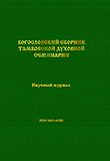Роль церковно-славянского языка в становлении и развитии речевой русской культуры
Ключевые слова:
церковно-славянский язык, старославянский язык, общеславянский литературный язык, древнеболгарский язык, русский литературный язык, речевая русская культура, святые равноапостольные Кирилл и Мефодий, духовная культура русского народа.Аннотация
В статье рассматривается роль церковно-славянского языка в становлении и развитии речевой русской культуры. Первые памятники славянской письменности были созданы первоучителями Кириллом и Мефодием как переводы греческих богослужебных книг. В лингвистике этот язык называется старославянским. В основе своей он отражает древнеболгарский язык, на котором говорили выходцы из города Солуни (Фессалоники, Салоники) - родины Кирилла (Константина) и Мефодия. Старославянский язык играет роль общеславянского литературного языка, потому что принадлежит к единой славянской культуре. С XI века появилось несколько редакций или изводов этого языка, которые отражают живую языковую среду своих народов: болгарскую, сербскую, русскую и др. Именно этот, пропитанный чертами местной славянской речи старославянский язык принято называть церковно-славянским. Естественно, что церковнославянский язык претерпел значительные изменения по сравнению со старославянским языком эпохи Кирилла и Мефодия: например, утратил носовые гласные. Особенное влияние оказал церковно-славянский язык на формирование духовной культуры русского народа. Автор приходит к выводу, что церковно-славянский язык - это мощный резерв и источник духовного семантического, звуко-оформительного, словообразовательного и стилистического обогащения русского литературного языка.
Скачивания
Библиографические ссылки
1. Полный православный богословский энциклопедический словарь / Репринтное изд., рекомендованное к печати Отделом религиозного образования и катехизации Московского Патриархата. М., 1992. Т. 1, 11.
2. Русский язык. Энциклопедия / Гл. ред. Ф.П. Филин М., 1979.
3. Свирелин А., прот. Церковнославянский словарь. М, 1997. Изд. 7.
REFERENCES
1. Polnyj pravoslavnyj bogoslovskij enciklopedicheskij slovar' / Reprintnoe izd., rekomendovannoe k pechati Otdelom religioznogo obrazovaniya i katekhizacii Moskovskogo Patriarhata. M., 1992. T. 1, 11.
2. Russkij yazyk. Enciklopediya / Gl. red. F.P. Filin M., 1979.
3. Svirelin A., prot. Cerkovnoslavyanskij slovar'. M, 1997. Izd. 7.
Загрузки
Опубликован
Лицензия
Copyright (c) 2025 Богословский сборник Тамбовской духовной семинарии

Это произведение доступно по лицензии Creative Commons «Attribution-ShareAlike» («Атрибуция — На тех же условиях») 4.0 Всемирная.

